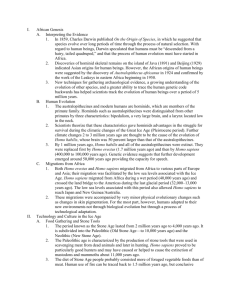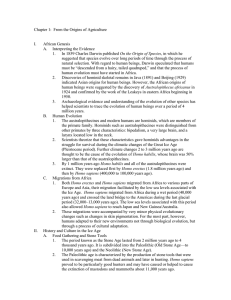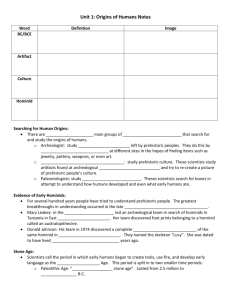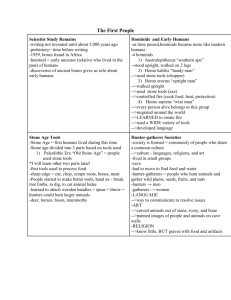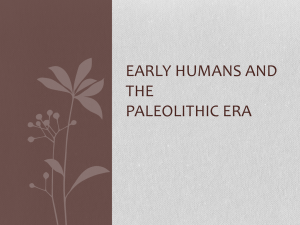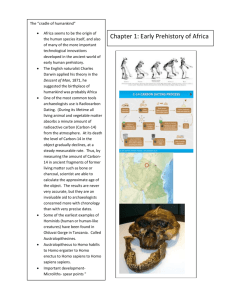Chapter Outline I. African Genesis A. Interpreting the Evidence 1. In
advertisement
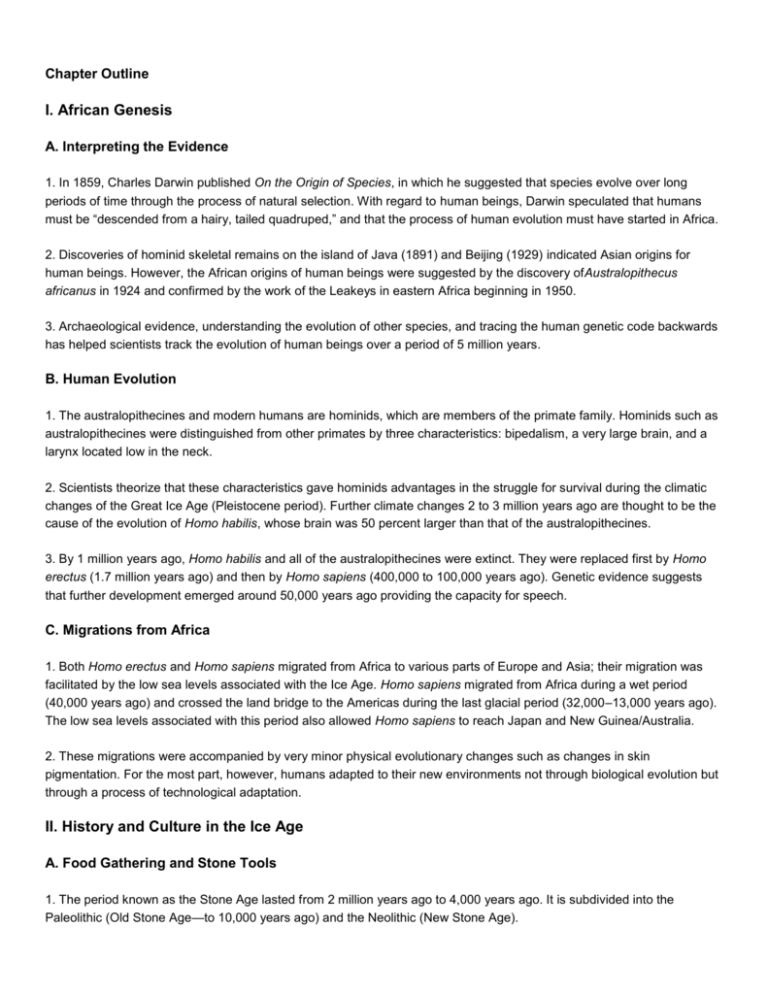
Chapter Outline I. African Genesis A. Interpreting the Evidence 1. In 1859, Charles Darwin published On the Origin of Species, in which he suggested that species evolve over long periods of time through the process of natural selection. With regard to human beings, Darwin speculated that humans must be “descended from a hairy, tailed quadruped,” and that the process of human evolution must have started in Africa. 2. Discoveries of hominid skeletal remains on the island of Java (1891) and Beijing (1929) indicated Asian origins for human beings. However, the African origins of human beings were suggested by the discovery ofAustralopithecus africanus in 1924 and confirmed by the work of the Leakeys in eastern Africa beginning in 1950. 3. Archaeological evidence, understanding the evolution of other species, and tracing the human genetic code backwards has helped scientists track the evolution of human beings over a period of 5 million years. B. Human Evolution 1. The australopithecines and modern humans are hominids, which are members of the primate family. Hominids such as australopithecines were distinguished from other primates by three characteristics: bipedalism, a very large brain, and a larynx located low in the neck. 2. Scientists theorize that these characteristics gave hominids advantages in the struggle for survival during the climatic changes of the Great Ice Age (Pleistocene period). Further climate changes 2 to 3 million years ago are thought to be the cause of the evolution of Homo habilis, whose brain was 50 percent larger than that of the australopithecines. 3. By 1 million years ago, Homo habilis and all of the australopithecines were extinct. They were replaced first by Homo erectus (1.7 million years ago) and then by Homo sapiens (400,000 to 100,000 years ago). Genetic evidence suggests that further development emerged around 50,000 years ago providing the capacity for speech. C. Migrations from Africa 1. Both Homo erectus and Homo sapiens migrated from Africa to various parts of Europe and Asia; their migration was facilitated by the low sea levels associated with the Ice Age. Homo sapiens migrated from Africa during a wet period (40,000 years ago) and crossed the land bridge to the Americas during the last glacial period (32,000–13,000 years ago). The low sea levels associated with this period also allowed Homo sapiens to reach Japan and New Guinea/Australia. 2. These migrations were accompanied by very minor physical evolutionary changes such as changes in skin pigmentation. For the most part, however, humans adapted to their new environments not through biological evolution but through a process of technological adaptation. II. History and Culture in the Ice Age A. Food Gathering and Stone Tools 1. The period known as the Stone Age lasted from 2 million years ago to 4,000 years ago. It is subdivided into the Paleolithic (Old Stone Age—to 10,000 years ago) and the Neolithic (New Stone Age). 2. The Paleolithic age is characterized by the production of stone tools that were used in scavenging meat from dead animals and later in hunting. Homo sapiens proved to be particularly good hunters and may have caused or helped to cause the extinction of mastodons and mammoths about 11,000 years ago. 3. The diet of Stone Age people probably consisted more of foraged vegetable foods than of meat. Human use of fire can be traced back to 1.5 million years ago, but conclusive evidence of cooking (in the form of clay pots) can only be found as far back as 12,500 years ago. B. Gender Roles and Social Life 1. The slow maturation rate of human infants and the ability of adult humans to mate at any time of the year are thought to be causes of the development of the two-parent family that is one of the characteristics of the hominids. 2. Researchers believe that in Ice Age society, women would have been responsible for gathering, cooking, and childcare, while men would have been responsible for hunting. The hunter-gatherers probably lived in fairly small groups and migrated regularly to follow game animals and to take advantage of seasonal variations in the ripening of foraged foods. C. Hearths and Cultural Expressions 1. Migrating hunter-gatherer groups lived in camps, using natural shelter when available and building temporary shelters when the climate required it; permanently established fishing communities made more solid structures. Clothing was made of animal skins sewn together with vegetable fiber and rawhide cords. 2. Hunter-gatherers probably had to spend no more than three to five hours a day on getting food, clothing, and shelter. This left them a certain amount of time for cultural activities: gathering, organizing and passing on information, art, and religion. 3. Cave art suggests that Ice Age people had a complex religion. Their burial sites indicate that they may have believed in an afterlife. III. The Agricultural Revolutions A. The Transition to Plant Cultivation 1. Agricultural revolutions—the domestication of plants and animals—were a series of changes in food production that occurred independently in various parts of the world. Changes in global climate were probably the cause of these transformations. 2. The first stage of the long process of domestication of plants was semicultivation, in which people would scatter the seeds of desirable food-producing plants in places where they would be likely to grow. The next stage was the use of fire to clear fields and specialized tools to plant and harvest grain. 3. The transition to agriculture took place first and is best documented in the Middle East, but the same sort of transition took place independently in other parts of the world, including the eastern Sahara, the Nile Valley, Greece, and Central Europe. Early farmers practiced swidden agriculture, changing fields periodically as the fertility of the soil became depleted. 4. The environments in which agriculture developed dictated the choice of crops. Wheat and barley were suited to the Mediterranean area; sorghum, millet, and teff to sub-Saharan Africa; yams to Equatorial West Africa; rice to eastern and southern Asia, and maize, potatoes, quinoa, and manioc to various parts of the Americas. B. Domesticated Animals and Pastoralism 1. Domestication of animals proceeded at the same time as domestication of plants. Human hunters first domesticated dogs; sheep and goats were later domesticated for their meat, milk, and wool. 2. As with plants, domestication of animals occurred independently in various parts of the world, and the animals domesticated were those that suited the local environment. In most parts of the world, the domestication of plants went along with the domestication of animals because animals were used for pulling plows and supplied manure for fertilizer. 3. There were two exceptions to the pattern of plant and animal domestication accompanying one another. In the Americas, there were no animals suitable for domestication other than llamas, guinea pigs, and some fowl, and so hunting remained the main source of meat, and humans the main source of labor power. In the arid parts of Central Asia and Africa, the environment was not appropriate for settled agriculture, but it could support pastoralists who herded cattle or other animals from one grazing area to another. C. Agriculture and Ecological Crisis 1. Most researchers agree that humans made the transition from hunter-gatherer to agricultural or pastoralist economies because the global warming between 6000 and 2000 B.C.E. brought with it environmental changes that reduced the supplies of game and wild food plants. The agricultural revolutions brought about a significant increase in the world’s human population—from 10 million in 5000 B.C.E. to between 50 and 100 million in 1000B.C.E. IV. Life in Neolithic Communities A. Cultural Expressions 1. The early food producers appear to have worshiped ancestral and nature spirits. Their religions centered on sacred groves, springs, and wild animals and included deities such as the Earth Mother and the Sky God. Some of these beliefs may be reflected in ancient Hindu texts. 2. Early food-producing societies used megaliths (big stones) to construct burial chambers and calendar circles and to aid in astronomical observations. 3. The expansion of food-producing societies may be reflected in the patterns in which the Indo-European, Sino-Tibetan, and Afro-Asiatic language groups are dispersed around the Eastern Hemisphere. B. Early Towns and Specialists 1. Most people in early food-producing societies lived in villages, but in some places, the environment supported the growth of towns in which one finds more elaborate dwellings, facilities for surplus food storage, and communities of specialized craftspeople. The two best-known examples of the remains of Neolithic towns are at Jericho and Çatal Hüyük. Jericho, on the west bank of the Jordan River, was a walled town with mud-brick structures and dates back to 8000 B.C.E. 2. Çatal Hüyük, in central Turkey, dates to 7000–5000 B.C.E. Çatal Hüyük was a center for the trade in obsidian. Its craftspeople produced pottery, baskets, woolen cloth, beads, and leather and wood products. There is no evidence of a dominant class or centralized political leadership. 3. The art of Çatal Hüyük reflects a continued fascination with hunting, but the remains indicate that agriculture was the mainstay of the economy. The remains also indicate that the people of Çatal Hüyük had a flourishing religion that involved offerings of food. Evidence indicates that the religion may have centered on the worship of a goddess and may have been administered by priestesses. 4. The remains at Çatal Hüyük include decorative or ceremonial objects made of copper, lead, silver, and gold. These metals are naturally occurring, soft, and easy to work, but not suitable for tools or weapons, which continued to be made from stone. 5. The presence of towns like Jericho and Çatal Hüyük indicates the emergence of a form of social organization in which food producers had to support nonproducing specialists such as priests and craftspeople and their labor had to be mobilized for nonproductive projects such as defensive walls, megalithic structures, and tombs. We do not know whether this labor was free or coerced. V. Conclusion A. Humans are descended from hominids that evolved in Africa about 7 million years ago. Modern human beings are descended from communities that evolved in Africa 50,000 years ago. B. Humans began developing a variety of tools more than 2 million years ago from stone, bone, skin, wood, and plant fiber. Though primarily vegetarian, Paleolithic people also used weapons to hunt. They developed a sexual division of labor and became knowledgeable about the natural world that provided them with clothing and medicine. C. Climate change drove early human communities to abandon hunting and gathering and develop agriculture and pastoralism, which consequently increased the global human population from 2 to 10 million in less than 10,000 years. D. Prosperity of the settled life during the Neolithic period led to the first towns, trade, and specialization. Archaeology reveals that humans developed forms of religion to recognize the cycles of death and rebirth.
